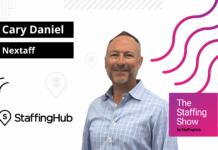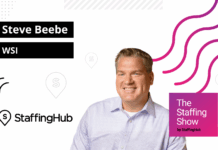
Key takeaways:
- Staffing analytics is shifting from rear‑view reporting to forward‑looking predictive intelligence that directly impacts revenue, margins, and client experience.
- Predictive models can forecast demand, recruiter capacity, candidate acceptance, and client churn, so long as you have clean data, the right tech stack, and data‑literate teams.
- Success depends as much on governance, privacy, and change management as on tools.
Staffing has always been a data‑rich business. For years, though, most agencies treated that information as exhaust, useful only for weekly reports and lagging KPIs.
But even incremental improvements in fill rate, time‑to‑start, or redeployment can translate into meaningful margin. So how do you move from basic reporting to predictive intelligence that reliably guides decisions?
From rear‑view reporting to predictive intelligence
Most staffing organizations fall somewhere along a continuum that begins with descriptive reporting, which focuses on answering “What happened?” through static monthly dashboards tracking metrics like revenue, gross margin, time-to-fill, and submittals per hire. This data often lives in siloed systems such as the ATS or scattered spreadsheets.
As firms mature, they advance to diagnostic analytics, asking “Why did it happen?” by segmenting performance data by client, recruiter, or vertical, and uncovering patterns such as underperforming branches or roles that routinely go unfilled.
The next stage, predictive intelligence, shifts the emphasis to “What is likely to happen next?” by generating forward-looking insights like job order and talent supply forecasts, as well as probabilities for offer acceptance, early attrition, or client churn.
The most advanced firms build on this foundation with prescriptive analytics, which helps answer “What should we do about it?” by surfacing recommended next actions for recruiters and sales teams and triggering automated workflows, such as targeted nurture sequences or redeployment campaigns, that address risks or opportunities in real time.
Instead of reading yesterday’s numbers, leaders get forward‑looking signals built into daily workflows: which requisitions risk missing their SLAs, which clients are likely to cut spend, and which candidates are most likely to accept (and stay).
Predictive models for demand forecasting and capacity planning
One of the highest‑value use cases for predictive analytics in staffing is demand and capacity planning.
Forecasting job orders
By combining historical job order data with external signals, models can estimate future demand at the desk, branch, and segment level. Typical inputs include:
- Seasonality (e.g., Q4 warehouse spikes, summer healthcare surges)
- Client‑specific patterns in order volume and cancellation rates
- Macroeconomic indicators and sector employment data
- Win rates by job type, pay rate, and location
The output is a rolling forecast of likely new orders, fills, and revenue by week or month. This helps you:
- Decide where to add or reassign recruiters and salespeople
- Prioritize verticals and geographies with the highest growth potential
- Plan sourcing campaigns in advance of peak season rather than reacting late
Modeling recruiter and delivery capacity
Pair that demand forecast with capacity models:
- How many reqs can a recruiter manage at once without degrading quality?
- How does automation, such as AI matching, auto‑screening, scheduling, change that ratio?
- What’s the realistic fill rate by job complexity?
Using historical data, you can estimate how many qualified submittals a recruiter can produce for each type of job, and how that translates into filled roles. As AI tools remove low‑value tasks, these models help you quantify the productivity gains and reassign headcount strategically instead of simply “working faster.”
Candidate behavior analytics that predict acceptance and longevity
For many agencies, the biggest profit leak isn’t finding candidates, but losing them at crucial moments: no‑shows, declined offers, and early quits after a few weeks on assignment. This is where predictive analytics shines.
Predicting offer acceptance
A candidate’s likelihood of accepting an offer is influenced by more than pay. Useful data signals include:
- Pay rate compared to local market benchmarks
- Commute distance or travel burden
- Shift patterns and schedule flexibility
- Time from application to offer (speed signals respect)
- Recruiter relationship history and communication cadence
- Channel of origin (referral vs. job board vs. talent pool)
By training models on past offers (accepted vs. declined), you can generate an acceptance probability score for each candidate‑job match. Recruiters then see:
- Which offers may require pay adjustments or benefits sweeteners
- Which candidates need a higher‑touch conversation before presenting an offer
- Which roles are at risk of repeat declines and need structural changes (e.g., shift, schedule)
Forecasting assignment longevity and redeployment
Similarly, models can estimate tenure and redeployment potential by examining:
- Prior assignment length and reasons for ending
- Candidate preferences like shift type, environment, and manager style
- Engagement signals like response times, survey scores, and referral activity
- Client factors like site culture, supervisor ratings, and previous turnover
These predictions help you:
- Flag placements with high early‑exit risk for proactive check‑ins
- Prioritize high‑redeployment candidates for new opportunities before their assignment ends
- Identify chronic issue roles or locations where job design, pay, or supervision must change
This moves staffing from a linear “place and forget” model to a cyclical “place, support, redeploy” lifecycle where longevity and lifetime value are managed like core metrics.
Client relationship analytics to spot at‑risk accounts and growth opportunities
A surprising number of client losses don’t come out of the blue. The warning signs are often visible in your own systems, but they may be scattered across ATS notes, CRM records, and billing data.
Predictive client analytics typically track:
- Volume trends: Declining job orders, fewer skill categories, or shrinking average order size
- Quality and speed metrics: Lower fill rates, more fall‑offs, or increasing time‑to‑submit
- Engagement signals: Fewer meetings, slower email responses, or reduced contact breadth (reliance on a single champion)
- Experience feedback: Net Promoter Score (NPS), complaints, or low scores on post‑assignment surveys
A churn model can convert these into a client risk score. Sales leaders can then:
- Prioritize “save the account” visits instead of guessing where to spend their week
- Match higher‑risk accounts with senior talent advisors or executive sponsors
- Test interventions, such as dedicated sourcing pods or pay‑rate adjustments, and track whether risk scores improve
The same data can highlight growth opportunities:
- Clients that send frequent, quickly filled orders but only in one department
- Sites where your fill rate and tenure exceed competitors’
- Contacts who frequently open your content but buy little today
In other words, predictive intelligence doesn’t just protect existing revenue; it points directly at where the next dollar should come from.
Technology requirements for advanced analytics capabilities
You can’t get to predictive intelligence on spreadsheets alone. But you also don’t need a Silicon Valley data lab. For most staffing agencies, a modern analytics stack has five core components:
- Integrated data foundation: Connect your ATS, CRM, timekeeping, pay/bill, and engagement tools into a central data warehouse. Use integration platforms or native connectors to keep data flowing continuously, not via monthly exports.
- Clean, governed data: Standardize fields for job titles, skills, locations, and stage definitions. Enforce data entry rules in front‑line systems (e.g., mandatory reason codes for fall‑offs). Establish clear ownership: who is responsible for keeping data accurate?
- Analytics and visualization tools include business intelligence (BI) platforms that allow leaders and managers to explore data without IT tickets and role‑specific dashboards embedded into recruiters’ and sales reps’ daily workflow, not buried in a portal.
- Machine Learning (ML) and AI capabilities such as tools that can train models on your historical data to predict outcomes like acceptance probability or churn. Increasingly, generative AI that sits on top of your data to answer natural‑language questions (“Show me clients with declining order volume and rising time‑to‑fill in the last 90 days”).
- Security, privacy, and auditability: Access controls by role, robust logging, and encryption in transit and at rest. Clear inventory of which vendors touch what data, and where that data resides.
The tech race is already underway. But it’s essential to align your infrastructure with concrete business questions rather than buying tools for their own sake.
Building data literacy within recruiting and sales teams
Even the best predictive models are useless if teams don’t trust or understand them, and in many staffing agencies the real barrier isn’t technology, but data literacy.
Leaders can build that capability by grounding analytics in the questions recruiters and salespeople already care about, such as which jobs they should prioritize today, which candidates are most likely to accept an offer, or which clients may be at risk of reducing spend. Starting with familiar, practical questions makes it easier to show how predictive analytics provides clearer, faster answers without overwhelming users with algorithms or math.
From there, agencies should standardize definitions to eliminate the common disputes that undermine trust, particularly around metrics like time-to-fill, what qualifies as an active or submitted candidate, and how open orders are counted. A simple data dictionary paired with consistent storytelling and accessible visuals helps everyone interpret metrics the same way.
Finally, analytics must become part of the daily rhythm: reviewing live dashboards during standups, checking candidate and job scores before outreach, and celebrating moments when data-driven insights lead to tangible wins such as preventing a client loss or reducing no-shows.
Over time, these practices shift analytics from a one-time initiative into a durable part of the agency’s culture.
Privacy, ethics, and compliance in advanced data usage
As staffing firms lean into AI and analytics, regulators and job seekers are watching closely. ASA’s Workforce Monitor reports that nearly half of employed U.S. job seekers (49%) believe AI tools used in recruiting are more biased than human decision‑makers. Whether or not that perception is fair, it is a reputational risk.
A few principles for responsible predictive intelligence:
- Be transparent: Let candidates and clients know when you use automated tools or AI to screen, score, or prioritize. Avoid “black box” processes that no one can explain.
- Minimize and purpose‑limit data: Collect only what you need for legitimate business purposes (e.g., placement, compliance, pay). Avoid feeding models sensitive or legally protected attributes, even if you have them.
- Monitor for bias and disparate impact: Regularly test models to see whether certain groups are systematically getting lower scores or fewer opportunities. Adjust inputs and thresholds when issues appear.
- Align with emerging regulations: Jurisdictions such as New York City and several U.S. states are introducing rules around automated employment decision tools, and California is moving ahead with AI‑related employment regulations that directly affect staffing firms. Work with legal counsel and industry associations to stay current.
- Keep humans in the loop: Use AI and predictive analytics to prioritize and surface insights, not to make final hiring decisions without human review. Recruiters and account managers should always have the authority and responsibility to override a score.
Rather than just a compliance checkbox, ethical analytics can become a brand differentiator.
The staffing industry is moving quickly from static reports to living, predictive systems that guide front‑line decisions in real time.
Take these steps to build a predictive intelligence engine that powers your next decade of growth:
- Clean and connect your data.
- Focus on a handful of high‑impact predictive use cases.
- Equip your recruiters and salespeople with simple, embedded insights.
- Govern it all with strong privacy, ethics, and compliance practices.
FAQ for staffing agency leaders
Q: We’re still mostly in spreadsheets. Can we really benefit from predictive analytics?
A: Yes, but you’ll need to tackle data basics first. Start by consolidating data from your ATS, CRM, and pay/bill system into a single, clean dataset. You don’t need a huge IT department; many mid‑market agencies start with light‑weight data warehouses and off‑the‑shelf BI tools, then layer in predictive models once the data is trustworthy.
Q: How big do we need to be for predictive models to work?
A: There’s no strict size threshold. What matters is data volume and consistency. If you have a few years of data with thousands of placements and reasonably consistent processes, you can train useful models, even as a regional firm. Smaller, niche agencies often get outsized benefits because their data is more homogeneous (same roles, similar clients).
Q: What’s the first predictive use case we should tackle?
A: For most firms, the best starting point is offer acceptance and fall‑off risk. These are painful, visible problems with plenty of data behind them. A simple model that flags candidates with high risk of declining or quitting early can immediately save time, protect client relationships, and build internal confidence in analytics.
Q: How do we get recruiters and sales reps to actually use the insights?
A: Design analytics as a product, not a report. Put scores and recommendations directly into the tools they already use (inside the ATS screen or CRM view) rather than in separate dashboards. Keep interfaces simple (green/yellow/red, risk scores out of 100) and connect them clearly to incentives: faster fills, happier clients, better commissions.
Q: Are we risking legal trouble by using AI to screen candidates?
A: You might, if you’re careless. Many jurisdictions now regulate automated employment decision tools. Work with counsel to:
- Document what your models do and what data they use
- Ensure humans review AI‑generated recommendations
- Provide candidates with appropriate disclosures and, where required, opt‑out options
Partnering with reputable vendors who understand staffing and compliance can also reduce risk, but they don’t replace your own governance responsibilities.
Q: How should we measure ROI on analytics and AI investments?
A: Tie metrics directly to business outcomes, such as:
- Reduction in time‑to‑submit and time‑to‑start
- Improvements in fill rate and redeployment rate
- Lower early‑tenure attrition
- Revenue growth or margin expansion in teams that adopt analytics compared with those that don’t





